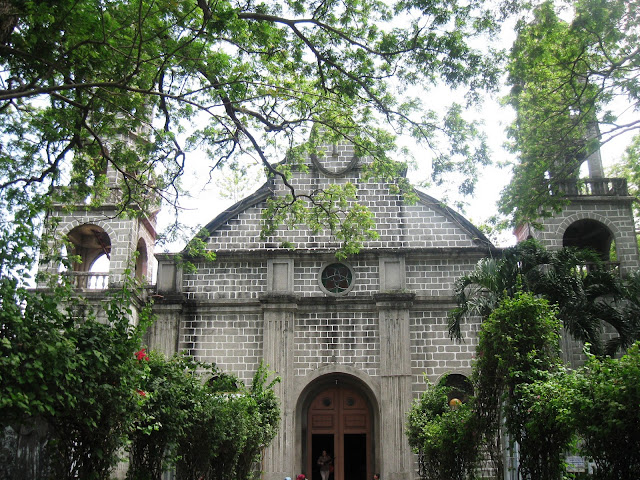Philippines is truly blessed with heritage churches scattered across the country. Almost every town has their own to be proud of. We have a tradition called visita iglesia (in Spanish meaning church visit) where a handful of churches are visited according to the Stations of the Cross every Holy Week. Since It's my very first time to do this, I asked the permission of my parents to travel and gave me tips of how/where to commute in different towns since they're busy in our church activities. My hometown is in Tanay, Rizal so I decided to explore and have a visit at Laguna province's churches, starting from the eastern corridor.
The town of Mabitac has a seal bearing the Our Lady of Candelaria Church at the top of the hill. From the local street, you'll have to pass a hundred steps to get there. After hearing the mass, I started to plan my itinerary using my Laguna map.
 |
| Only the church bell tower was left intact |
Walking toward Siniloan, this bustling town has a renovated Sts. Peter & Paul Church located near municipal grounds.
A jeepney ride will take you to the town of Pangil with Our Lady's Nativity Church at the town's square. Housed here are the images of Infant Jesus and Pregnant Mother Mary.
The silent town of Pakil is proud of their long-running Turumba festival in honor of Our Lady of Sorrows. The beautiful façade of St. Peter of Alcantara Church was left intact with majestic mountainous background.
Paete has an imposing St. James The Apostle Church with holy images carved by local artists and showcasing the artistry of the townsfolk.
Kalayaan town used to be called Longos. Saint John the Baptist Parish is situated near the lake so it withstood numerous floods caused by Laguna de Bay. It was once abandoned as the new town center was transferred to a nearby barangay. Today, Longos just applies to the barangay at the northern part of Kalayaan, Laguna.
Famous for their embroidery, Lumban was also famous for their local parish, St. Sebastian Church on a nearby town hall.
At the eastern crossroads of Laguna, Pagsanjan has Our Lady of Guadalupe Church where its miraculous image was believed to save the town from invaders.
I chose the Sta. Cruz route since the jeepneys going to different towns are plying around the town's square. Immaculate Conception Church somehow left the façade partly intact.
A short jeepney ride will lead you to the Heritage Town of Pila. Modeled after a colonial Spanish town plan, the St. Anthony of Padua Church is placed across the town hall on a plaza.
From Sta. Cruz, I rode a jeepney going to the sleepy town of Magdalena where the namesake St. Mary Magdalene Church served as a refuge to our hero, Emilio Jacinto, as his blood stains are protected by a marker at the church's convent.
Further south and you'll reach the town of Liliw. Famous for their slippers and delicacies, the St. John The Baptist Church stands proudly on a hilly terrain with mountainous backdrop.
The last stop of my one-day church visit is at Nagcarlan. St. Bartholomew Church remained intact and believed to be connected to the famous underground cemetery through a tunnel.
The next day, I visited the churches at Western Laguna. With a different route, I never got lost because of my reliable map. I went directly to Calamba City where our national hero, Jose Rizal was born. He was baptized at St. John The Baptist Church where his baptismal certificate is displayed at the baptistry.
The progressive town of Cabuyao has an old church near the town plaza. St. Polycarp Church is a mute witness to the execution of local martyrs during the colonial period.
The renovated St. Rose of Lima Church at Sta. Rosa City is adjacent to the former municipal hall, now a city's museum.
Located at the town's square, the St. Isidore The Laborer Parish of Biñan City stands next to the old municipal hall.
Finally, another progressive town in Laguna, San Pedro is famous for jasmine blossoms or sampaguita. Flower vendors are a common sight infront of St. Peter The Apostle Church.
The church of Los Baños, Immaculate Conception Parish Church is home to the venerated image of Nuestra Señora del Aguas Santas (Our Lady of the Holy Waters). The miraculous image is attributed to the healing waters of the hot springs/baths where the town is known for.
Even it's very recent, my Mt. Banahaw loop church visit included a city and a town in Laguna. First is the St. Paul the First Hermit Cathedral at San Pablo City. This is the seat of the Diocese of San Pablo, covering all churches in Laguna province.
In Luisiana town, Nuestra Señora del Rosario Parish is nestled at the back of municipal hall.
The Transfiguration of Our Lord Parish of Cavinti is located in a hilly terrain where the patron saint is El Salvador del Mundo (Divine Savior of the World).
Though I missed some heritage churches at Laguna province, soon I'll update this post once I visited bastions of faith when I embarked on another journey. Again, here is my visita iglesia route:
Eastern corridor (Day 1): Mabitac-Siniloan-Pangil-Pakil-Paete-Kalayaan (Longos)-Lumban-Pagsanjan-Sta. Cruz-Pila-Magdalena-Liliw-Nagcarlan
Western corridor (Day 2): Calamba City-Cabuyao-Sta. Rosa City-Biñan City-San Pedro
Central-Southern: Los Baños-Bay-Victoria-San Pablo City-Majayjay-Luisiana-Cavinti
Central-Southern: Los Baños-Bay-Victoria-San Pablo City-Majayjay-Luisiana-Cavinti
Have a blessed journey everyone! (n_n)

























No comments:
Post a Comment